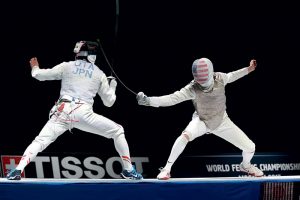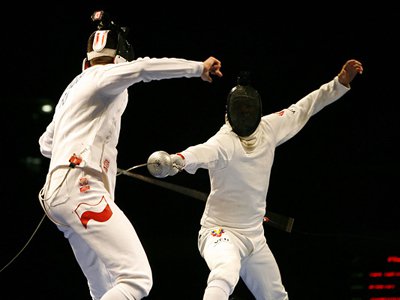Wounds and injections: how professional fencers work
 Seven-time world champion, nine-time European champion, numerous champion of our country – in general, the “first saber of the world” Sophia the Great helped us to understand the rules of fencing and to love this exciting sport with all my heart.
Seven-time world champion, nine-time European champion, numerous champion of our country – in general, the “first saber of the world” Sophia the Great helped us to understand the rules of fencing and to love this exciting sport with all my heart.
The World Fencing Championship, held in July in the capital’s Olympic, gave us a surprise. And the matter is not in the scale of the event, although they are amazing: 912 athletes from 108 countries showed up for the competition. And not even in the triumph of the Russian national team, which was well deserved and expected, so it does not attract surprise.
Arriving at the championship at the invitation of Tissot, the official timekeeper of the competition, we unexpectedly saw a fantastic show that, due to its entertainment and intensity of passions, will shut up any rock concert. The epithet “fantastic” describes the electrified equipment of the participants, in which they look like alien invaders, and the inhuman speed of their movements. The same word comes to mind when the paths under the feet of athletes (one would like to call them a “scene”) flash in bright colors in synchronization with masked lights, illustrating the injection. And of course, fantastic decibels are given out by spectators, supporting the tournament hosts – the Russian team.
There are many spectators in the stands, and applause now and then is heard out of place: to understand the rules of sports fencing at first is not easy. To understand how fights on rapiers, swords and sabers differ, it is worth making a short excursion into history.
Stab, not chop
The first swords appeared in Spain in the middle of the 15th century in response to the proliferation of plate armor. It was practically impossible to cut all-metal plates with a sword, but an accurate piercing blow to the joint of the armor could bring the fighter victory. The epee was a long sword with a narrow double-edged (and later even faceted) blade, intended primarily for stabbing, not chopping. A characteristic feature of the sword is a complex guard that protects the hand and allows you to repel the enemy’s attacks with economical short movements, and not with sweeping force.
Despite the formal presence of blades, the rapier was too light for chopping hits. And yet it turned out to be a good weapon of self-defense. Instead of a shield, a fencer with a rapier used a dagger or dagu (a special dagger for the left hand with a developed guard). So the principle of “stabbing, not chopping” went into a duel, although plate armor was not used in them.
In Italy, sword fencing was taught using training weapons with a faceted blade without blades and a blunt tip instead of a point. In Italian, such a weapon was called fioretto, in English it became known as foil, and in Russian it remained a rapier. Blows were allowed to be applied only to the torso: firstly, the students wore leather protective vests, and secondly, stabbing blows to the arm or leg were considered ineffective – after them the enemy could still continue the fight.
A saber is a universal weapon that can chop and stab equally well. Sabers were especially loved by cavalrymen for their cutting properties, due to the characteristic bend of the blade. The three main disciplines of modern fencing (saber, sword and rapier) essentially correspond to their historical roots. But looking at the weapon, you can’t say this. Externally, the sports sword, rapier and saber are so similar to each other that only an experienced fan can distinguish one shell from another.
All blades are absolutely straight. Of course, none of them has a blade, and each is crowned with a blunt tip. They all bend well, because in the event of a breakdown they could instantly turn into a sharp military weapon. Yes, the sword is slightly heavier and somewhat tougher due to the trihedral blade (the rapier has a tetrahedral blade, the sword has a trapezoid blade). There are other features, but still the main difference is in the rules for holding fights.
The lantern will judge
The simplest rules for the fencers: the point is received by the one who first gives the injection. The score goes by a split second, so fencers can not do without the electrical fixation of injections. The sword tip is a kind of button that fires with a force of 7.4 N (750 gf). Light touch with the opponent’s sword will not be counted. By the way, good injections with a sports sword are very sensitive.
Two-wire wiring from the tip passes through the gutter along the blade and connects to the connector hidden behind the guard. A wire is connected to the connector, which passes through the sleeve of the protective jacket and connects to the device. Until recently, the connection was always wired: moving along the track, the athlete pulled the wire from an inertial coil, like from a tape measure. Today, the coil is replaced by a radio transmitter. “Fencing with a wireless system is very convenient,” says Sophia the Great, “the coil has a weak, but still noticeable resistance to movement. In rare cases, the wire does not have time to wound up properly and gets tangled. ”




